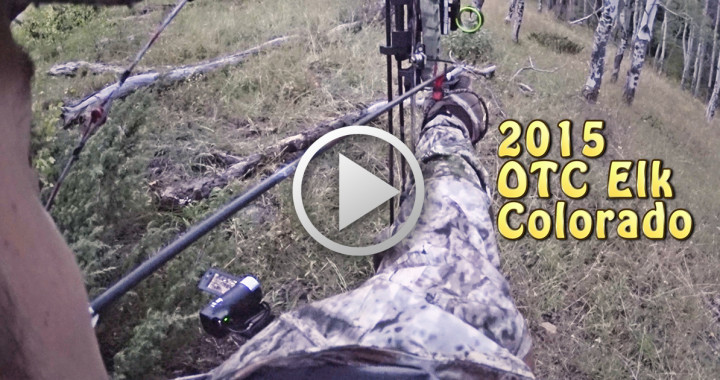Here’s the video from our OTC Colorado elk hunt in 2015. The success rate last year in this wilderness unit was 6%. It’s big country and steep terrain, not for the out-of-shape. While I was bow hunting, the other guys in our group were using muzzleloaders. Colorado laws prohibit scopes or pelletized powder for muzzleloaders. Covering a lot of ground to scout and hunt the new area would be an understatement. I traced my routes to the best of my memory in Google Earth, and found that I’d covered over 37 miles and climbed and descended over 6,000 feet during the trip. A lot of that was in the dark traveling to and from camp and the hunting spots.
THOUGHTS ABOUT THE TRIP
The only trip we have under our belts to compare this one to is the 100% draw rifle hunt that we did last year. The weather was much colder, we had snow, and the hunting pressure was much higher. Going into this Sept 12-20 elk hunt we knew that the temps would be milder which allowed us to pack accordingly. We also planned on being able to utilize bugling to locate bulls during the rut. We picked the unit that we did because it had wilderness in it. Wilderness = no wheeled transportation. In our case it also meant steep, rugged terrain. Our only company was pack horses and backpackers just as crazy as we were. From an elk standpoint, the area wasn’t loaded, but it held its fair share. Bugling activity was pathetic, but we still saw silent bulls while hunting travel routes. In fact, every bull we saw had decent headgear… 4×4 or better. That’s something which can’t be said about a lot of Colorado’s OTC units. But remember, the success rate was 6% last year. So having a couple nice bulls running around over several square miles is far from a done deal.
RUT vs FEEDING PATTERNS
Pick up any magazine or book… watch any DVD or TV show about September elk hunting. It usually starts off with a group locating a bull by his bugle, sneaking in close, and either seducing him with cow calls or aggravating him into bow range with intrusive bull sounds. The bull comes in screaming, and the hunter gets a shot. Well, let me say this. When the elk aren’t bugling – as was the case on this trip – it becomes very hard to build a plan like that. We didn’t even hear bugling at night. I believe the lower elk density combined with hunting pressure caused many of the bulls to be call shy and naturally quieter unless in their comfort zone. The only bugles I heard were within thick dark timber between 9am and 1pm (and how exciting of an experience it was!). During peak travel times and in more open areas, the elk were silent. We nearly had success on a couple of occasions just setting up silently along those routes. By the 2nd or 3rd day, we noticed where the elk were traveling from their beds between 10000 and 10800ft toward the foot sources below 9000. Having four people to set up and watch each morning and afternoon expedited that scouting process. People saw elk, and even had shot opportunities. If I would have had a muzzleloader, I’m confident I could have punched my tag on a bull the 3rd morning at 65 yards… or the cow at 60 yards assuming I had a cow tag. But hey, that’s the price I pay for bringing a bow! The moral of our story is… if the rut activity sucks, give deer hunting tactics a try.
GOOD ENOUGH SHAPE?
I already mentioned how much ground I covered on this trip. I think I covered more than the rest of the group, who spent more time sitting and less time running and gunning. Much of the travel was from base camp to an early morning perch and back after dark. You see, water availability forced us to camp at 8800 feet. The farthest I traveled in one morning was 2 hours and 15 minutes. That by itself doesn’t say much… because the real test would have been if we had downed an elk. Having four guys, the only real way to do it (apart from calling a packer for a couple hundred bucks) is to have each guy hike a quarter back to the vehicle. Then one or two continue to grab the antlers, cape, and remaining meat, drive to a nearby town and get it on ice. Basically, it would have been a day of hunting lost for at least one guy with an unfilled tag. We knew that going in. For the older guys in the group, hiking 1000 feet elevation gain, then hiking down 2000 feet with a quarter, then back 1000 feet up to base camp would have been incredibly exhausting by itself, and may have taken even more time out of their trip. So I’ll say this, it’s not enough to be in good enough shape to climb around the mountain and hunt. You ideally want to be in as good of shape as possible so that helping out with packing reduces everyone’s hunting time as little as possible in my opinion.
THE FUTURE:
I’ll be back in that unit at some point, no doubt. Whether or not it’s for elk or mule deer is yet to be decided. The mule deer hunting in some of those wilderness areas can be pretty good, and most even offer early rifle tags that non-residents can draw with a few points. I’m beginning to build preference in WY for what may be a hunt with much less pressure (and perhaps more responsive bulls). There are other states I’m looking at as well, but $100+ non-refundable application fees for a preference point in a state you might not draw for several years doesn’t appeal to me that much.
